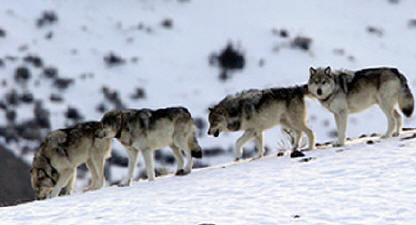|
Written by Julia Zeh
Edited by Ashley Koo Along the grassy ocean floors and the valleys of Yellowstone National Park there exists a landscape of fear. Although this phrase conjures up the image of a horror movie, the landscape of fear is really an ecological phenomenon involving fear’s relationship to natural predator-prey relationships. This important phenomenon is produced by apex, or top, predators, like sharks and wolves. When one member of an ecosystem is impacted, naturally the entire ecosystem feels its effects. These impacts take the form of something called a trophic cascade. The word ‘trophic’ refers to a process related to feeding or nutrition, so a trophic cascade is a trickle down, or up, effect on a food chain. Changes in the population size of a certain species can cause an increase or decrease in another population of another species because of the connections created between different groups of organisms by their predator-prey relationships. Trophic cascades are an indirect result of predation, so even top predators can indirectly influence plants. Each group of organisms is kept in check by every other group with which it comes into contact, either directly or indirectly. A landscape of fear is a trophic cascade. When it occurs, the mere presence of top predators can influence animal behavior and thus entire ecosystem dynamics. This landscape of fear phenomenon has been witnessed in Yellowstone National Park with the return of the wolves. In the 1920s, the last of the Yellowstone wolf population was completely eliminated. In the 1990s, however, the decision was made to reintroduce wolves to Yellowstone. With the wolves back in the park, it was believed that the entire ecosystem would be healthier. By the time the wolves returned to Yellowstone, the plant populations had been drastically decreased. A trophic cascade had occurred. With the loss of the wolves, the elk population – the wolves’ primary prey – had exploded. In consequence to the sudden increase in elk, plant populations suffered a huge blow. This impacted populations of aspen trees in particular, which the elk would graze on before the trees could grow particularly tall. Once the wolves returned, however, the elk population was back in check and the aspen population also normalized. But direct predation wasn’t the only impact of the wolves; wolves also changed the behavior of the elk. The elk were spending more time in flat areas to graze and far less time in riskier areas that would be harder to escape if wolves showed up. Trees and shrubs could grow considerably larger in these places because the elk that would normally consume them before they could grow very tall were now avoiding the areas. Entire ecosystems that rely on larger plants were revived in the areas the elk considered risky, all because of an atmosphere of fear induced by the presence of wolves in the area. Interestingly, a landscape of fear is also produced by tiger sharks and can cause a change in behavior of dugongs. Dugongs and tiger sharks live together off the coast of Australia, exhibiting a typical predator-prey relationship. Dugongs are large marine mammals, the Australian and East Asian equivalent of the American manatee, and are preyed on by large tiger sharks. Affectionately nicknamed sea cows, they graze on, and thus seriously impact the populations of, seagrass that grows along the ocean floor. Just like the elk, the dugongs adapt their behavior to the presence of predators, taking less risks in where they feed, and thus impacting the plant populations of the ecosystem. When sharks are present, dugongs overuse the seagrass in deeper areas which have less seagrass for them to consume. The potential for food is higher in shallow areas, but so is the potential for a shark attack. This is particularly important in determining how seagrass population structure may be drastically impacted, though indirectly, by the tiger shark population. As we observe more of the relationships between and behaviors of organisms, we continue deciphering the interrelatedness of the natural world. Whole ecosystems are influenced through trophic cascades, which can occur through fear induced behavioral changes. The landscape of fear is not just a fascinating aspect of animal behavior and ecology (and a name that would excite anybody, regardless of their science background), it also has enormously important conservation implications. The landscape of fear, along with other ecological phenomena, demonstrates the multitude of connections among different forms of life on earth. The ecological phenomenon reminds us just how cautious we as humans need to be as the ones who have huge impacts on other organisms. If humans eliminate or even just displace or decrease one small population of species lower on the food chain, the effects on countless other organisms can be catastrophic. Humans have already had a fatal impact on tiger sharks, which are threatened, and wolves, which are endangered. The predators themselves are at risk, and thus entire ecosystems in which the predators have important influences on population sizes and behaviors are too. Each living thing is an important component of a bigger web that spans the globe, and damage to one part damages the whole.
0 Comments
Leave a Reply. |
Categories
All
Archives
April 2024
|

